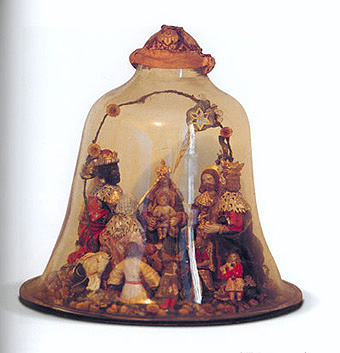The piece of the month of December 2005
A CONVENT NATIVITY SCENE IN THE ARRESE COLLECTION OF CORELLA
Ricardo Fernández Gracia
Chair of Navarrese Heritage and Art
The history of the nativity scene in Navarre is part of a set of traditions around Christmas that must be correctly interpreted as manifestations of the spiritual and cultural personality of a people, immersing oneself in the soul of a human group and trying to rediscover a bit of its identity, historically defined through multiple aspects in which its culture is embodied. Precisely for this reason, some nativity scenes constitute true cultural assets and can be specifically suitable as condensers of these values, due to their material and singular presence, since, in contrast to the incorporeal character of some cultural elements, the scenography of a traditional and popular nativity scene constitutes a physically concrete object, with a high symbolic value, which assumes and summarizes the essential character of the culture to which it belongs.
Navarre did not remain alien to the diffusion of the nativity scene in European lands and in other Spanish regions, from the XVII century onwards. The nobility and, particularly, some religious institutions took great care to possess outstanding sets, some of which have been preserved and constitute today a magnificent reference of the nativity scene art in the centuries of the Ancien Régime.
The first three-dimensional assemblies of the birth of Christ, which is precisely what a nativity scene is, were those of the Discalced Carmelite nuns of San José de Pamplona in Navarre, in the first third of the 17th century, and the Jesuits of the same city, in the middle of that century. The best example of those preserved is the monumental nativity scene of the Augustinian Recollect Nuns of the capital of Navarre, which attracted great attention on the occasion of the inauguration procession of the chapel of the Virgen del Camino, in 1776.
There are some outstanding works from the 18th century, especially in showcases or windows, as well as a set in polychrome wood made by the sculptor Juan José Vélaz in 1825 for the parish of Mendigorría. Special mention should be made of all the Murcian clay imported in the 19th century, when the nativity scene became popular in the homes of towns and cities.

Bell with the Epiphany from the Arrese Collection of Corella, from the Carmelites of Araceli, XVIII century.
We present in the illustration that accompanies this text a fanal that contains inside a beautiful set that is exhibited in the Arrese Collection of Corella and comes from the Monastery of Discalced Carmelites of Araceli in the same city. The scene composes a miniature Epiphany, inside a glass bell, with clay and terracotta figures of delicate invoice, acquired outside the convent or made with financial aid molds by the nuns themselves. In this regard we must remember that two female cloistered convents, the Discalced Carmelite nuns of Araceli de Corella and the Capuchin nuns of Tudela have been the two great centers of contemplative life linked to popular religiosity in the Ribera de Navarra. It is not by chance that both have preserved delicate showcases, those of Corella currently in the Arrese Collection and those of Tudela in situ. In the past, many polychrome clay figures of numerous saints, both of the Order and of popular invocations, were made in Corella. The secular molds, very destroyed by their use and the passage of time, give good faith of it. Among the little chapels of conventual craftsmanship that the daughters of Santa Teresa distributed among their devotees were those of St. Joseph, the Virgin of Carmen, the Virgin of Araceli, St. Michael the Archangel, as well as others such as St. Sebastian, St. Teresa, St. John of the Cross or the Child Jesus. The contemplation of the crystal bell that contains the Epiphany and the showcase that we present, is accompanied by a carol that is still interpreted by the nuns when they go up to the choir on Christmas Eve.
Zagalas del Carmelo,
let us run, let us run to Bethlehem,
for they are already in the cave,
The Virgin and St. Joseph.
Carmel's witches,
let us run, let us run to Bethlehem,
to keep them company,
with the mule and the ox.
The dirty portalico will be,
the blessed Saint will clean it
let's not leave this chore to him,
for all of them will be in great and lively faith,
with great and lively faith,
and flooded with joy,
we shall sweep it away.
The Virgin is in prayer,
very high in contemplation,
for the hour is at hand,
the Angels surround her,
who will court the Child King,
your little maidens, too,
they will make him behind the mule and the ox.
Zagalas del Carmelo .....
